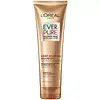What's inside
What's inside
 Key Ingredients
Key Ingredients

 Benefits
Benefits

 Concerns
Concerns

 Ingredients Side-by-side
Ingredients Side-by-side

Water
Skin ConditioningCoco-Betaine
CleansingDisodium Laureth Sulfosuccinate
CleansingSodium Cocoyl Isethionate
CleansingSodium Lauryl Sulfoacetate
CleansingSodium Lauroyl Sarcosinate
CleansingGlycol Distearate
EmollientSodium Chloride
MaskingDecyl Glucoside
CleansingParfum
MaskingPolyquaternium-10
Amodimethicone
PPG-5-Ceteth-20
EmulsifyingSodium Hydroxide
BufferingCitric Acid
BufferingPEG-55 Propylene Glycol Oleate
Propylene Glycol
HumectantCarbomer
Emulsion StabilisingAcrylates/Beheneth-25 Methacrylate Copolymer
Tocopherol
AntioxidantBenzophenone-4
UV AbsorberBenzoic Acid
MaskingTrideceth-6
EmulsifyingMagnesium Nitrate
Linalool
PerfumingCamelina Sativa Seed Oil
Skin ConditioningSodium Benzoate
MaskingPrunus Armeniaca Kernel Oil
MaskingCetrimonium Chloride
AntimicrobialVitis Vinifera Seed Oil
EmollientCoumarin
PerfumingTetrasodium EDTA
Methylchloroisothiazolinone
PreservativeMagnesium Chloride
Methylisothiazolinone
PreservativeHelianthus Annuus Seed Oil
EmollientRosmarinus Officinalis Extract
AntimicrobialFish Oil
Skin ConditioningWater, Coco-Betaine, Disodium Laureth Sulfosuccinate, Sodium Cocoyl Isethionate, Sodium Lauryl Sulfoacetate, Sodium Lauroyl Sarcosinate, Glycol Distearate, Sodium Chloride, Decyl Glucoside, Parfum, Polyquaternium-10, Amodimethicone, PPG-5-Ceteth-20, Sodium Hydroxide, Citric Acid, PEG-55 Propylene Glycol Oleate, Propylene Glycol, Carbomer, Acrylates/Beheneth-25 Methacrylate Copolymer, Tocopherol, Benzophenone-4, Benzoic Acid, Trideceth-6, Magnesium Nitrate, Linalool, Camelina Sativa Seed Oil, Sodium Benzoate, Prunus Armeniaca Kernel Oil, Cetrimonium Chloride, Vitis Vinifera Seed Oil, Coumarin, Tetrasodium EDTA, Methylchloroisothiazolinone, Magnesium Chloride, Methylisothiazolinone, Helianthus Annuus Seed Oil, Rosmarinus Officinalis Extract, Fish Oil
Water
Skin ConditioningCetearyl Alcohol
EmollientStearamidopropyl Dimethylamine
EmulsifyingCocos Nucifera Oil
MaskingHydrolyzed Elastin
EmollientSea Salt
AbrasiveHydrolyzed Keratin
HumectantHydrolyzed Wheat Protein
Skin ConditioningPanthenol
Skin ConditioningTocopheryl Acetate
AntioxidantAscorbic Acid
AntioxidantParfum
MaskingBehentrimonium Chloride
PreservativeLactic Acid
BufferingDipropylene Glycol
HumectantPotassium Chloride
Trehalose
HumectantDisodium EDTA
Gluconolactone
Skin ConditioningDMDM Hydantoin
PreservativeAdipic Acid
BufferingSodium Sulfate
Methylchloroisothiazolinone
PreservativeMethylisothiazolinone
PreservativeWater, Cetearyl Alcohol, Stearamidopropyl Dimethylamine, Cocos Nucifera Oil, Hydrolyzed Elastin, Sea Salt, Hydrolyzed Keratin, Hydrolyzed Wheat Protein, Panthenol, Tocopheryl Acetate, Ascorbic Acid, Parfum, Behentrimonium Chloride, Lactic Acid, Dipropylene Glycol, Potassium Chloride, Trehalose, Disodium EDTA, Gluconolactone, DMDM Hydantoin, Adipic Acid, Sodium Sulfate, Methylchloroisothiazolinone, Methylisothiazolinone
Ingredients Explained
These ingredients are found in both products.
Ingredients higher up in an ingredient list are typically present in a larger amount.
MCI is a preservative and known skin-irritant. It has anti-bacteria anti-fungal properties.
Studies spanning several decades have shown this ingredient to cause skin irritation and allergies.
MCI is commonly combined with methylisothiazolinone (MI). Other names for this mixture include Kathon CG and Euxyl K 100.
The use of this ingredient varies around the world:
Learn more about MethylchloroisothiazolinoneMI is a preservative and known skin irritant. In the past, MI was used for its ability to prevent bacteria, yeast, and fungi growth in low doses.
Nowadays, you'll most likely see MI combined with Methylchloroisothiazolinone (MCI). Trade names for this combination include Kathon CG or Euxyl K 100.
Since then, numerous studies have shown this ingredient to cause contact dermatitis, or skin irritation.
The use of this ingredient varies around the world:
Learn more about MethylisothiazolinoneParfum is a catch-all term for an ingredient or more that is used to give a scent to products.
Also called "fragrance", this ingredient can be a blend of hundreds of chemicals or plant oils. This means every product with "fragrance" or "parfum" in the ingredients list is a different mixture.
For instance, Habanolide is a proprietary trade name for a specific aroma chemical. When used as a fragrance ingredient in cosmetics, most aroma chemicals fall under the broad labeling category of “FRAGRANCE” or “PARFUM” according to EU and US regulations.
The term 'parfum' or 'fragrance' is not regulated in many countries. In many cases, it is up to the brand to define this term.
For instance, many brands choose to label themselves as "fragrance-free" because they are not using synthetic fragrances. However, their products may still contain ingredients such as essential oils that are considered a fragrance by INCI standards.
One example is Calendula flower extract. Calendula is an essential oil that still imparts a scent or 'fragrance'.
Depending on the blend, the ingredients in the mixture can cause allergies and sensitivities on the skin. Some ingredients that are known EU allergens include linalool and citronellol.
Parfum can also be used to mask or cover an unpleasant scent.
The bottom line is: not all fragrances/parfum/ingredients are created equally. If you are worried about fragrances, we recommend taking a closer look at an ingredient. And of course, we always recommend speaking with a professional.
Learn more about ParfumWater. It's the most common cosmetic ingredient of all. You'll usually see it at the top of ingredient lists, meaning that it makes up the largest part of the product.
So why is it so popular? Water most often acts as a solvent - this means that it helps dissolve other ingredients into the formulation.
You'll also recognize water as that liquid we all need to stay alive. If you see this, drink a glass of water. Stay hydrated!
Learn more about Water